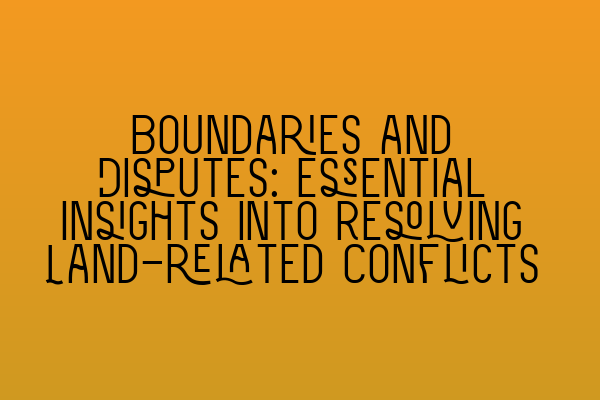Boundaries and Disputes: Essential Insights into Resolving Land-related Conflicts
As a property owner, it is crucial to have a clear understanding of your land boundaries. Boundaries not only define the limits of your property but also determine your rights and responsibilities as a landowner. Unfortunately, land-related conflicts are not uncommon, and disputes over boundaries can arise for various reasons, leading to significant legal and financial implications. In this blog post, we will explore the essential insights into resolving land-related conflicts and provide you with valuable information to better navigate such situations.
1. Recognizing the Importance of Accurate Boundaries
Accurate boundaries are the foundation of property ownership and are established to ensure legal security and prevent disputes. They help determine the extent of your land rights, including ownership and use. Boundaries can be physical, such as fences, walls, or hedges, or they can be defined through legal documents, like deeds and surveys.
2. Common Causes of Boundary Disputes
Boundary disputes can arise due to various reasons, including:
– Unclear or poorly defined boundaries: Vague or ambiguous boundaries can lead to misunderstandings between neighbors.
– Changes to boundaries over time: Land may be altered due to natural processes, such as erosion or flooding, or human activities, like construction or land encroachment.
– Lack of maintenance or repair: Neglecting the upkeep of physical boundaries can lead to disagreements over responsibilities and maintenance costs.
– Inaccurate or conflicting land records: Discrepancies in property records, surveys, or deeds can result in disputes over boundary lines.
3. Steps to Resolve Boundary Disputes
Resolving boundary disputes can be a complex and sensitive process. If you find yourself in such a situation, it is essential to follow these steps:
– Step 1: Communication: Openly discuss the issue with your neighbor to understand their perspectives and reach a mutual agreement, if possible.
– Step 2: Consult legal professionals: If communication fails to resolve the dispute, seek advice from a knowledgeable property law solicitor who specializes in land disputes. They can guide you through the legal complexities and provide you with an accurate assessment of your rights and options.
– Step 3: Gathering evidence: Collect all relevant documents, including property records, surveys, and photographs, to support your claim or defense in court.
– Step 4: Mediation: Mediation is often a preferable method for resolving boundary conflicts. A neutral third party, such as a mediator, can help facilitate negotiations and assist both parties in finding a mutually acceptable resolution.
– Step 5: Litigation: In some cases, litigation may be necessary to resolve the dispute. If all other options fail, your solicitor can help you navigate the court system and present your case.
4. Importance of SEO in Property Law
In this digital age, having an online presence is vital for any law firm, including SQE Property Law & Land Law. Search Engine Optimization (SEO) plays a significant role in boosting online visibility and attracting potential clients.
By integrating relevant keywords into website content, blog posts, and other online materials, law firms can improve their search engine rankings and target specific audiences. For instance, keywords like “boundary disputes,” “property law solicitor,” or “land-related conflicts” can attract individuals seeking assistance with land disputes and increase the likelihood of potential clients discovering SQE Property Law & Land Law’s services.
5. Additional Resources and Courses
To further your understanding of property law, dispute resolution, and prepare for the SQE (Solicitors Qualifying Examination), consider exploring the following related articles and resources:
– SQE 1 Practice Exam Questions: Test your knowledge and readiness for the SQE 1 exam with practice exam questions provided by SQE Property Law & Land Law.
– SQE 1 Practice Mocks FLK1 FLK2: Gain extra preparation with practice mocks specifically designed for SQE 1, provided by SQE Property Law & Land Law.
– SQE 2 Preparation Courses: Prepare for the SQE 2 exam through specialized courses offered by SQE Property Law & Land Law.
– SQE 1 Preparation Courses: Enhance your understanding of property law and other relevant topics with SQE 1 preparation courses offered by SQE Property Law & Land Law.
– SRA SQE Exam Dates: Stay informed about the upcoming SRA SQE exam dates to ensure timely registration and preparation.
In conclusion, resolving land-related conflicts requires a deep understanding of boundaries and legal processes. By recognizing the importance of accurate boundaries, understanding common causes of disputes, following the appropriate steps, and seeking professional advice, you can effectively navigate boundary conflicts. Additionally, integrating SEO techniques can help law firms like SQE Property Law & Land Law establish a strong online presence and attract potential clients. Remember to explore the additional resources and courses mentioned above to further enhance your knowledge and readiness in property law and the SQE exams.
(Note: The content of this blog post is for informational purposes only and should not be considered legal advice. Always consult a qualified solicitor for advice specific to your situation.)
